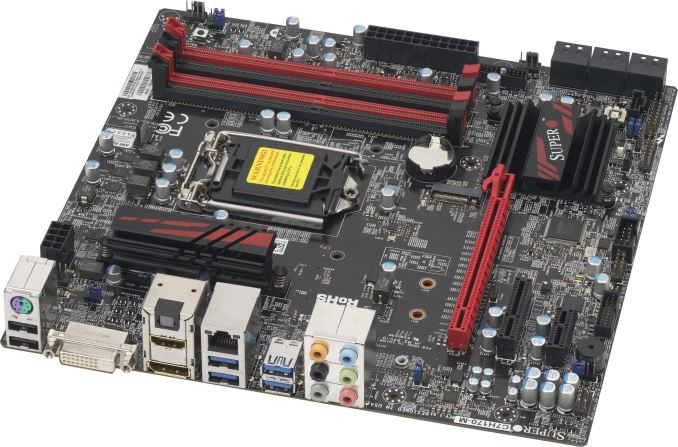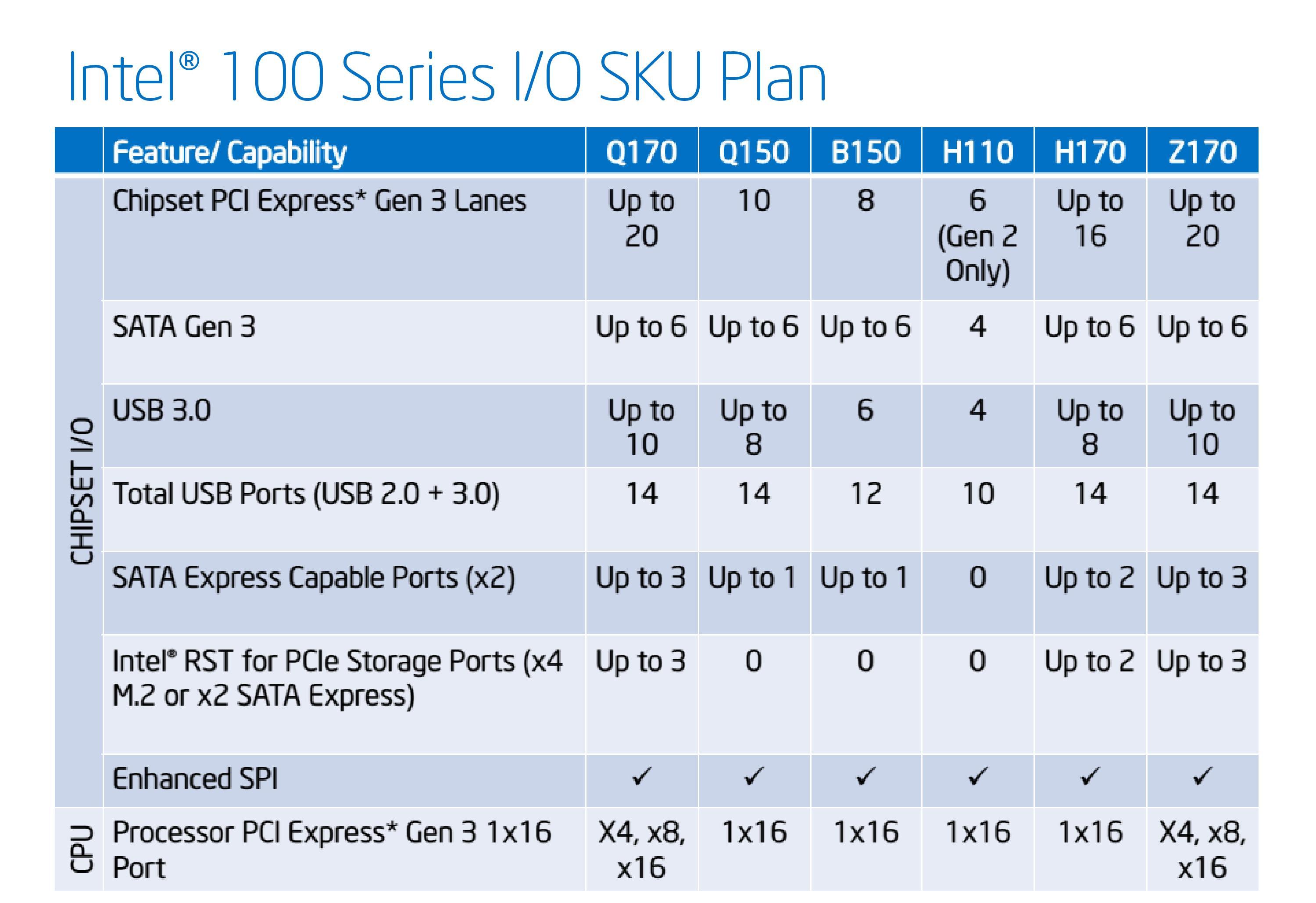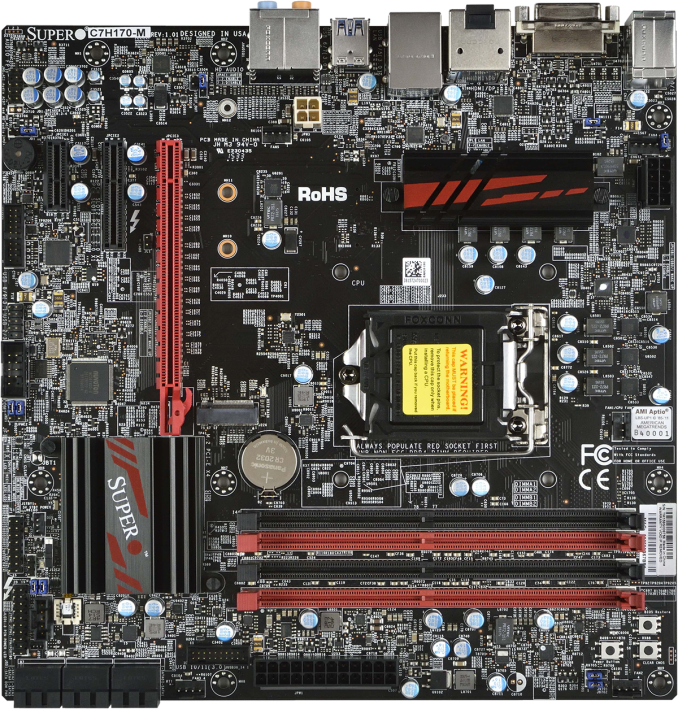Why an Overclockable Core i3 Might Not Exist: The Supermicro C7H170-M and Intel Core i3-6100TE Review
by Ian Cutress on March 17, 2016 10:30 AM EST- Posted in
- CPUs
- Intel
- Motherboards
- Core i3
- Supermicro
- Overclocking
Supermicro Going Consumer
When it comes to consumer grade motherboards, or at least on the enthusiast side, our coverage consists of 90%+ of the top four manufacturers - mostly due to sales figures and reader interest. Every so often we get in a sample from the next tierof vendor, which can throw us for a curveball based on price, software and/or utility. Arguably Supermicro is in this latter crowd, purely in terms of consumer volume, but they have been a primary Intel partner for two decades and make most of their revenue in the enterprise space. Back in Computex 2015, I sat down with one of the CEOs main advisors and we spoke about the consumer motherboard space, and how/if/whether Supermicro should launch into the area. At the time mentioned three points to them:
- The base quality of consumer motherboards is a relatively high bar to match. The four main companies going at it have had multiple generations of learning, updating, fixing and tweaking their design. Customers expect a lot, even at the bottom end of the market.
- The motherboard market is declining in volume. Each manufacturer is redoubling efforts to maintain their sales volume, let alone keeping their market share. This means having engineers, good marketing, and a clear working relationship with customers on all levels, some of which Supermicro may not be familiar with
- Brand presence and technical prowess are the main avenues to get people talking about your product. Having both the correct stack of parts for your customers as well as something new and innovative (either livery or active feature) is how users will understand your parts, and simple gimmicks are easy to see through.
At the time, Supermicro were quietly confident. They have large technical teams, albeit server based, and a large number of enterprise customers that would appreciate the server touch at a consumer grade sale. However, I would argue that from my perspective, 2014 and 2015 were relatively dull from Supermicro. We technically had the Z87 overclocking motherboard in for review, for example, but I read several reviews where the BIOS needed a lot of work, the software was non-existent, and enthusiasts wanting to push the boat were going nowhere.
We never got around to reviewing the motherboard, due to time constraints with other reviews, but Supermicro was willing to listen to my feedback last year on the state of the industry. They have since moved to selling motherboards through the regular retail channels to get a semblance of market share, and are also trying to build a brand around the SuperO name, which has seen several motherboards launched for Skylake including this green one we reported on late last year. But by some swift engineering, Supermicro managed to be at the center of one of the most interesting overclocking stories in a number of years.
The OC story started with the motherboard we are reviewing in this piece, the C7H170-M. If you read the previous page, we go through the trials and tribulations of how base frequency over clocking on Intel non-K processors is fundamentally encouraged by the base CPU design but was locked by default, then enabled if certain hardware changes were made, then locked again by firmware, but might be re-enabled in certain circumstances. Throughout the debacle, Supermicro has held firm and not removed any product from the market, but is also being tight lipped on their updates.
Supermicro C7H170-M Overview
At $128 as the current retail price over at Newegg, the Supermicro C7H170-M is the cheapest motherboard we have tested on the Skylake platform so far, but also uses the cheaper H series chipset in a microATX sized motherboard. The H170 chipset is the first step down from the high end Z170, and as such comes with a few more restrictions. H series chipsets, for example, are designed for systems that incorporate a single discrete graphics card (which fundamentally covers most PC users), and have a lower number of high speed ports for PCIe based RAID storage or extra controllers connected to the chipset.
As for the motherboard, it's clear that Supermicro are taking things like livery a bit more seriously. The board is busy - lots of contact pads, pin-connection switches and new sizes/combinations of push buttons. This is mixed with the new color scheme, which can be a bit off putting. But for $128, there are a number of points both positive and negative on the bill of materials.
At this price point I was glad to see an Intel I219-V network controller as well as the high end Realtek ALC 1150 audio code. Typically with a cheaper motherboard, audio and networking are the first to be downgraded but Supermicro has kept them here. We have no USB 3.1 unfortunately, which is atypical from our 100-series coverage so far, but the board has support for all the USB 3.0 ports that the chipset offers. As a server motherboard company we get a trusted platform module header as well as a power switch, but not a two-digit debug display for error codes. At this price point and board size there is a full complement of memory slots, supporting JEDEC speeds up to 16GB per module of DDR4. This is a motherboard that isn't really built for overclocking, despite the nature of this review, so as a result we get a five phase power delivery design using standard server-grade VRMs and chokes.
On the BIOS and software side, it is clear that Supermicro has a lot of work still to do in terms of user experience. They have transitioned from a bland BIOS interface to something graphical, though it is significantly clunky with both mouse speed and the ease of use of the keypad to move into certain sections. There’s also the utility aspect, such as fan controls, which have been reduced the optimal or full-speed only. I would say that the overclocking options, although basic, give an easy way for most people to go and overclock by offering an automatic look-up-table in 5 MHz increments.
The software stack uses monitoring software, oddly through a HTML interface which is probably indicative of how server systems are usually controlled (even though we don’t have an IPMI connection here). That being said, the software tool does provide a lot of information, even though it is not as extensive as what the regular consumer motherboard manufacturers provide.
Performance was a mixed bag in the grand scheme of things, albeit with a few interesting segments above the price band: there’s no Multi-Core Turbo here, the DPC Latency was high and POST times are beyond 30 seconds, but the power consumption between idle and load is decent enough and the audio results put the solution as one of the best we’ve tested so far on Skylake.
At this point, for $128, the C7H170-M comes across as a nice motherboard to have, but only if it comes with the overclocking feature and/or retains its position as the only motherboard capable of non-Z and non-K base frequency overclocking. That’s where the true value lies, mostly because there are other motherboards in this price range that have more features. As it currently stands, base clock overclocking is still listed on retailers as its main feature (3/17), so if it still says that when purchased but is removed at a later date, I would assume it could be returned.
Quick Board Feature Comparison
| Motherboard Comparison | ||
| Supermicro C7H170-M | ||
| Socket | LGA1151 | LGA1151 |
| MSRP at Review | $128 | $230 |
| DRAM | 4 x DDR4 | 4 x DDR4 |
| PCIe Layout | x16 | x8/x8 |
| BIOS Version Tested | v1.0c | 142 |
| MCT Enabled Automatically? | No | Yes |
| USB 3.1 (10 Gbps) | No | ASMedia ASM1142 1 x Type-A 1 x Type-C |
| M.2 Slots | 1 x PCIe 3.0 x4 | 2 x PCIe 3.0 x4 |
| U.2 Ports | No | No |
| Network Controller | 1 x Intel 219-V | 1 x Killer E2400 |
| Audio Controller | Realtek ALC1150 | Realtek ALC1150 |
| HDMI 2.0 | No | No |













62 Comments
View All Comments
ViperV990 - Thursday, March 17, 2016 - link
The i5-6400 @ $180 seems to be a much better part to OC.nightbringer57 - Thursday, March 17, 2016 - link
Heh, when some of the younger ones today speak about overclocking, I like to remember them of how much more financially interesting overclocking used to be. It's like everyone forget how overclocking worked a few years ago. I still remember my cheap student gaming PC with a Pentium E2180 that went from 2GHz to 3GHz with a standard tower rad and only a slight voltage boost. Then you could have almost all of the performance of the 300€ CPUs (except a good bit of the cache) for 60€ or so. Multiplier overclocking is easier, yes, and it's good to reach insane peak frequencies - but this market of the "buy low, push high" overclocking has faded out (courtesy, of course, of the segmentation by core numbers as well)BrokenCrayons - Thursday, March 17, 2016 - link
Oh yeah, well I overclocked when there were still turbo buttons on the fronts of AT cases! So nyah nyah!Sarcasm aside though, drawing a line in the sand to mark when overclocking was "good" or "worthwhile" and when it stopped being fun or have any sort of point would result in an awful lot of people drawing an awful lot of lines all over the place. For instance, the last processor I bothered with overclocking was a 2GHz Pentium 4 derived Celeron. Pushing the FSB from 100 to 150MHz on an Intel boxed cooler with a little bit of extra voltage netted a 3GHz chip...which rapidly became highly unstable over the course of a few months. After that and numerous PIIs, PIIIs, the infamous Celeron 300A and whatnot, I got bored with it and my priorities shifted. I would have overclocked my VIC-20 and Trash 80 if I'd known more about computers because I couldn't resist tinkering. I think if one were to ask other people, they'd find different points in time and different processor technologies so it's probably unfair to people who are simply by nature of the date of their birth, unable to discuss overclocking in terms you're more comfortable with.
nightbringer57 - Thursday, March 17, 2016 - link
Yes, but still. There had been a more or less constant trend of tinkering around with low-end CPUs to get quasi-high-end performance out of them for quite a long time. I quote my old E2180, but over the "modern" history of computers (that is, in the current context, IBM PC and their heir), there had always been such shenanigans available to the tinkerers. If you go further in time, the trend fades as the modern concept of CPU "range" fades out and it came more down to boosting your X - generation CPU to still have a bit more oomph after most of the software environment of you given platform had moved to a new generation.And not only Intel processors, but AMD processors as well, with the pencil unlockable Durons and whatnot.
As this article states, this kind of overclocking has more or less died in recent years, partly due to technical issues (as systems get more and more complex and integrated, it becomes riskier), partly due to the current state of the market, partly due to marketing practices.
It's not about discussing overclocking in terms I personally am comfortable with or whatnot. It's just about being realistic. I hope that AMD can come back with Zen and bring a bit more freshness into the low-end overclocking market.
Spoelie - Friday, March 18, 2016 - link
Still had a lot of fun in the period between 2000-2010 with the Athlons, always buying the lowest end SKU of the performance line, and ocing between 20-40% to reach the same performance of the highest end SKU in the line.E.g.
On an nForce2 board IIRC
* Athlon XP 1800+ (Socket A Thoroughbred 256KB cache) 1533mhz OC to ~2ghz
* Athlon XP 2500+ (Socket A Barton 512KB cache) FSB166 to FSB200 = OC to "3200+"
Had a Athlon 64 2800+ on a Socket 754 for a very short time, don't remember what I did to it.
Then a "DFI LanParty UT NF4 Ultra-D" (Socket 939 w/ nForce4 & 2*512MB Winbond BH-5 PC3200 @ 250mhz 2-2-2), cream of the crop at the time.
* Athlon 64 3000+ (Venice) OC 1800 to 2250 (250bus)
* Opteron 165 (Toledo) OC 1800 to 2475 (274bus)
I loved those days
Murloc - Sunday, March 20, 2016 - link
yeah I remember a 45nm core 2 duo I had, with the boxed stock cooler I was able to lower the voltage quite a bit and daily OC it at 4GHz at the same time.It was a lucky piece compared to others.
cobrax5 - Monday, March 21, 2016 - link
I'm thinking about replacing my 45nm i7-930 @ 3.8ghz with a hex-core, 32nm Xeon and OC that to > 3.6ghz. You can get them for like under $200, and I'll keep my (admittedly aging) X58 platform.benedict - Thursday, March 17, 2016 - link
Single-threaded benchmarks show this processor to be much better than what it'd be in real life. I don't know if there are people who only run a single program at a time on their PCs. Having more cores is much more valuable than most benchmarks will show.TheinsanegamerN - Thursday, March 17, 2016 - link
I can run 7 programs at once, but if one is very demanding and is single threaded, then single threaded performance is still quite relevant. Multiple programs/=/not needing single threaded performance. Thinking that single threaded performance is not important got AMD the FX series, and subsequently a large portion of their users jumping to intel.calculagator - Thursday, March 17, 2016 - link
Everyone is different, but single threaded benchmarks give a much better picture of performance for "normal" users than multithreaded in my experience. Even if they have lots of programs running, most users are only using one program at a time. All of those open documents and web tabs use very little CPU power while they just sit there. I have about 100 active processes right now, but my CPU is idling at about 3% usage.Even a basic dual-core CPU can handle most users' multitasking. The most common exceptions are gaming and video editing, but most users are not doing those things most of the time. Consider how people use laptops so often: their CPUs have such high single-threaded/burst performance that they hardly notice how much less powerful they are than much more powerful desktop CPUs.